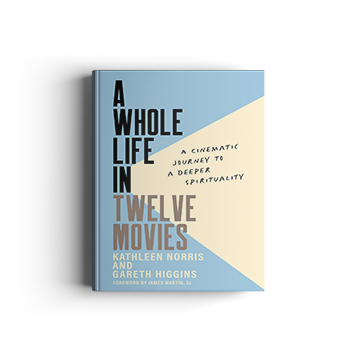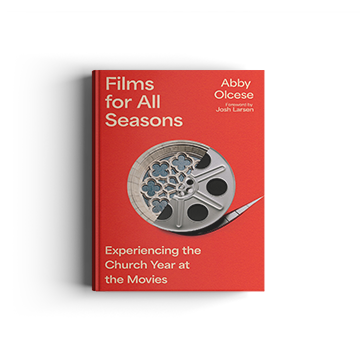Each of these writers is deepening the vital conversation between the films we make and watch, and the beliefs we hold dear.

A Whole Life in Twelve Movies: A Cinematic Journey to a Deeper Spirituality
Kathleen Norris and Gareth Higgins
(BrazosPress 2024)

Films for All Season: Experiencing the Church Year at the Movies
Abby Olcese
(IVP)

Theology of Horror: The Hidden Depths of Popular Films
Ryan G. Duns, S.J.
(Notre Dame Press)
For film lovers, the start of a new year is often marked by the anticipation of long-awaited movies. Summer brings blockbuster season, which in recent years has meant the debut of the latest Marvel installments and big budget sequels. Meanwhile the fall and winter seasons normally bring “prestige” releases, films destined for award campaigns for the Golden Globes and Oscars. Then there are the monthly and holiday rhythms as well: horror flicks for Halloween in October, Christmas tales in December, and if we want to be expansive in our approach, maybe even Easter in the spring?
Okay look, that last one might be a stretch, but I’ll never turn down the opportunity to sing the praises of Critters 2: The Main Course, which just so happens to feature a hilarious and bloody massacre of an Easter bunny inside a church.
Three new books take these rhythmic patterns even further, suggesting that the movies that surround us can inform and mark our lives’ milestones (A Whole Life in Twelve Movies: A Cinematic Journey to a Deeper Spirituality by Kathleen Norris and Gareth Higgins), the Church calendar (Films for All Seasons: Experiencing the Church Year at the Movies by Abby Olcese), and specifically, how one film genre reveals deeper truths about who we are (Theology of Horror: The Hidden Depths of Popular Films by Ryan G. Duns). In so doing, each of these writers is deepening the vital conversation between the films we make and watch, and the beliefs we hold dear.
For Norris and Higgins, A Whole Life in Twelve Movies offers a compelling framework: What if we used films to help us interpret and engage with life’s pivotal moments? From birth to death, success and conflict, childhood and community, each chapter is written in halves, with each author providing their own reflections on the films as they put them conversation with the period of life being highlighted. Thus, 2001: A Space Odyssey becomes a dialogue partner with the process of waiting to be born, Babette’s Feast is a meditation on generosity, and What Maisie Knew informs certain aspects of childhood. Each chapter ends with a series of questions, making it the perfect companion to group discussions centered around film.
As a fan of maligned/misunderstood/unsung art in general (see the aforementioned Critters shoutout), I was particularly happy to see Wonder Woman 1984 in their list of films. I’m not sure if we’ve reached a over-saturation point when it comes to the proliferation of superhero/comic book movies being made, but we’ve certainly gotten to a stretch where the newness has worn off and seeing one not perform to a studio’s expectations isn’t unusual. Which makes WW84’s inclusion all the more compelling. By choosing a mainstream movie that didn’t meet those massive expectations, Norris and Higgins give us an example of a vital gift that theology and film together can bring to the table: a critical reevaluation of a movie and its themes after the initial debut and marketing push has faded into the background.
Shifting gears over to Olcese’s Films for All Seasons, the theological connections get even more pronounced and explicit as she maps movies onto central observances in the Christian calendar: Advent, Epiphany, Lent, and so on. It should be noted that her suggestions for Easter (The Iron Giant and The Chronicles of Narnia: The Lion, the Witch, and the Wardrobe) certainly offer the reader a lot more to chew on than my Critters recommendation. Notably, Olcese begins the journey by inviting us onto a specific path of engagement modeled after the practice of lectio divina: viewing (instead of reading), meditation, and contemplation. Thus we get Annihilation welcoming us into the season of Lent via Ash Wednesday, or The Night of the Hunter providing an unusual backdrop to the celebration of Christmas.
Olcese’s choice of dialogue partners throughout are compelling and thought-provoking across the board. Her love and appreciation of both the church calendar and the films themselves comes through in every portion of the text. I often struggle with the former due to the ways in which American evangelicalism often strip-mines observances for the sake of spectacle, but Olcese’s book is a potent reminder of the truths within these church traditions, offering fresh visions via the films featured. This is indeed a wonderful gift.
Lastly, we come to Ryan G. Duns’ Theology of Horror. Flashback with me for a moment, to when I was about 5 or 6. My dad let me watch the 1960 version of The Time Machine with him one Saturday afternoon. I can still remember where we were in our house; he was sitting in an overstuffed arm chair and I was perched on his lap, completely hooked on the tale of the Eloi and the Morlocks. Yet the practical effects terrified me so much, I had nightmares and fitful sleep for over a week. Perhaps paradoxically, I was drawn more and more to sci-fi and horror with each passing year, and as a 45 year old, they remain central genres in my viewing habits. All that to simply say this: I’m absolutely the target audience for Duns’ work here. I watch horror films year-round, and a book centered on the theological exploration of iconic works of terror is right up my alley.
From classics like Night of the Living Dead and A Nightmare on Elm Street, to more recent entries such as The Purge and The Black Phone, Duns enters into conversation with these films via a central assertion: In cultural milieus where considerations of the divine and/or the transcendent are no longer dominant, horror presents a ready-made context for these discussions, in large part due to the very fabric of the genre itself. As a location where questions of good vs. evil are played out over and over again, he argues that horror carves out a space where everyone can still wrestle with spiritual and metaphysical concerns.
His analysis of Texas Chain Saw Massacre (one of my all-time favorite movies) is a terrific example of the work he’s doing here: “Horror films function best when they address the vulnerability of the body and frustrate our attempts to understand our world.” From here he navigates conversation partners from the fields of philosophy and linguistics, returning to the text of the film itself to weave together with his theological engagements. Of the three books considered here, Duns is the most academically dense and thus might be best suited for reading and discussion within a classroom setting. This is not to say that it is unapproachable in any way, but rather that he dives into the deep end of the pool and the reader simply needs to be ready to dive in with him.
As my work and research in this field continues, I’m increasingly convinced that helpful, life-giving dialogue between culture and theology requires a starting point of love: for ourselves, for one another, for God, and also for the art itself and the people behind it. I’m not saying that we have to be passionate and equally excited about every film we’ve ever watched, but a foundational love for the art form and the craft is crucial for engaging with it in a generous and loving manner. As such, I am grateful for these four authors and the work they’ve done in these texts. It is clear just how much they love and appreciate film and theology and, with them, the various spaces where each in tandem can speak into our individual and communal paths.





